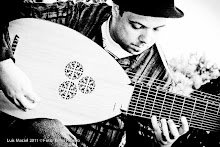 In the year of 711, a line of highly advanced Muslims invaded the poorly defended Iberian Peninsula and established the Caliphate of Al-Andalus.
In the year of 711, a line of highly advanced Muslims invaded the poorly defended Iberian Peninsula and established the Caliphate of Al-Andalus.The Arabs, among many things, established in the peninsula the taste for arts and the erudite cult of a musical instrument called "oud" ("Ud" in some countries) that later would originate the European lute. They were also the first to establish a music conservatory in Spain by the virtuoso of that time, Zyriab.
As the picture shows, this instrument also has a half-pear shape and to date is commonly used in music of the Middle East and Eastern Mediterranean countries. It differs from the European lute for not having frets (traces on the neck of the instrument) and because it is played with a plectrum (pick).
The oldest image of an Oud dates back to 5000 years ago, in the current city of Nassiriyah in Iraq. This detail caused me enormous impact, because it is possible to imagine the ancient civilizations of the Middle East and Mediterranean already using chordophones (string instruments) in their music. From the Sumerians, Acadians, Persians, Babylonians, Assyrians, Armenians, Greeks, Egyptians and Romans, to the Turks, who later brought the Oud to the battles, by the belief in the magical powers of this instrument.
(português)
No ano de 711, uma linhagem de muçulmanos extremamente avançados invadiu a Península Ibérica mal defendida e estabeleceu o Califado de Al-Andalus.
Os árabes, entre muitas coisas, estabeleceram na Península o gosto pelas artes e o culto erudito de um instrumento musical chamado “oud” (“Ud” em alguns países) que mais tarde daria origem ao alaúde europeu. Foram também os primeiros a estabelecer em Espanha um conservatório de música através do virtuoso da época, Zyriab.
Como a imagem mostra, este instrumento também tem formato de meia-pêra e até aos dias de hoje é comumente usado na música do Médio Oriente e países do Mediterrâneo Oriental. Distingue-se do alaúde europeu por não ter trastes (traços no braço do instrumento) e por ser tocado com palheta.
A imagem mais antiga de um Oud remonta a 5000 anos atrás, na atual cidade de Nassiriyah no Iraque. Esse detalhe causou-me enorme impacto, pois é possível imaginar as civilizações da Antiguidade no Médio Oriente e Mediterrâneo já usando cordofones (instrumentos de corda) na sua música. Dos Sumérios, Acadianos, Persas, Babilônios, Assírios, Armémios, Gregos, Egípcios e Romanos até aos Turcos, que mais tarde traziam o Oud para as batalhas, pela crença nos poderes mágicos desse instrumento.



No comments:
Post a Comment